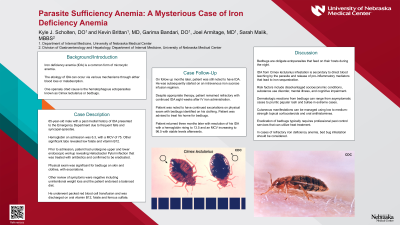Sunday Poster Session
Category: GI Bleeding
P0806 - Parasite Sufficiency Anemia: A Mysterious Cause of Iron Deficiency Anemia
Sunday, October 27, 2024
3:30 PM - 7:00 PM ET
Location: Exhibit Hall E

Has Audio

Kyle Scholten, DO
University of Nebraska Medical Center
Omaha, NE
Presenting Author(s)
Kyle Scholten, DO, Kevin Brittan, MD, Garima Bandari, DO, Luis Zuniga, DO, Jonathan Herskovitz, MD, PhD, Joel Armitage, MD, Sarah Malik, MD
University of Nebraska Medical Center, Omaha, NE
Introduction: Iron deficiency anemia (IDA) is a common form of microcytic anemia. The etiology of IDA can occur from blood loss, malabsorption, or other miscellaneous causes. One sparsely cited cause is the hematophagous ectoparasites known as Cimex lectularius or bedbugs. We present a case of unexplained refractory iron deficiency anemia that resolved after the treatment of bedbugs.
Case Description/Methods: A 65-year-old male presented to the emergency department due to frequent falls and syncopal episodes. Hemoglobin on admission was 6.3, with a MCV of 75. Other significant labs revealed low folate and vitamin B12. Past medical history was significant for a two-year history of IDA. Patient had previously undergone upper and lower endoscopic workup with findings significant for Helicobacter Pylori infection. The infection was confirmed to be negative after eradication therapy. Physical exam was significant for bedbugs on skin and clothes, with excoriations. The patient endorsed a well-balanced diet and denied any unintentional weight loss. Due to symptomatic IDA, patient underwent packed red blood cell transfusion and was subsequently discharged on oral vitamin B12, folate, and ferrous sulfate.
On follow-up, IDA persisted despite oral iron supplementation. Intravenous (IV) iron sucrose was then initiated. However, IDA remained unresolved despite IV supplementation. Physical exam findings continued to show excoriations on the skin and bedbugs on his clothes at the time of the follow-up visit. The patient was advised to speak to his landlord for bedbug treatment of his home. After the patient’s home was treated for infestation, his hemoglobin and MCV rose to 13.5 and 96.5, respectively, and remained stable on routine monitoring thereafter.
Discussion: We report a case of refractory IDA secondary to Cimex lectularius (bedbugs) infestation. Bedbugs are obligate ectoparasites that feed on their hosts during the night. Disadvantaged socioeconomic conditions, substance use disorder, mental illness, and cognitive impairment may put patients at increased risk of severe infestation. There is sparse literature on cases of IDA secondary to bedbug bites. The mechanism of IDA secondary to Cimex lectularius infestation is thought to be two-fold – direct blood leeching by the parasite and release of pro-inflammatory mediators that lead to iron sequestration and lower hemoglobin. Clinicians should be aware of Cimex lectularius infestation in refractory iron deficiency anemia cases.
Disclosures:
Kyle Scholten, DO, Kevin Brittan, MD, Garima Bandari, DO, Luis Zuniga, DO, Jonathan Herskovitz, MD, PhD, Joel Armitage, MD, Sarah Malik, MD. P0806 - Parasite Sufficiency Anemia: A Mysterious Cause of Iron Deficiency Anemia, ACG 2024 Annual Scientific Meeting Abstracts. Philadelphia, PA: American College of Gastroenterology.
University of Nebraska Medical Center, Omaha, NE
Introduction: Iron deficiency anemia (IDA) is a common form of microcytic anemia. The etiology of IDA can occur from blood loss, malabsorption, or other miscellaneous causes. One sparsely cited cause is the hematophagous ectoparasites known as Cimex lectularius or bedbugs. We present a case of unexplained refractory iron deficiency anemia that resolved after the treatment of bedbugs.
Case Description/Methods: A 65-year-old male presented to the emergency department due to frequent falls and syncopal episodes. Hemoglobin on admission was 6.3, with a MCV of 75. Other significant labs revealed low folate and vitamin B12. Past medical history was significant for a two-year history of IDA. Patient had previously undergone upper and lower endoscopic workup with findings significant for Helicobacter Pylori infection. The infection was confirmed to be negative after eradication therapy. Physical exam was significant for bedbugs on skin and clothes, with excoriations. The patient endorsed a well-balanced diet and denied any unintentional weight loss. Due to symptomatic IDA, patient underwent packed red blood cell transfusion and was subsequently discharged on oral vitamin B12, folate, and ferrous sulfate.
On follow-up, IDA persisted despite oral iron supplementation. Intravenous (IV) iron sucrose was then initiated. However, IDA remained unresolved despite IV supplementation. Physical exam findings continued to show excoriations on the skin and bedbugs on his clothes at the time of the follow-up visit. The patient was advised to speak to his landlord for bedbug treatment of his home. After the patient’s home was treated for infestation, his hemoglobin and MCV rose to 13.5 and 96.5, respectively, and remained stable on routine monitoring thereafter.
Discussion: We report a case of refractory IDA secondary to Cimex lectularius (bedbugs) infestation. Bedbugs are obligate ectoparasites that feed on their hosts during the night. Disadvantaged socioeconomic conditions, substance use disorder, mental illness, and cognitive impairment may put patients at increased risk of severe infestation. There is sparse literature on cases of IDA secondary to bedbug bites. The mechanism of IDA secondary to Cimex lectularius infestation is thought to be two-fold – direct blood leeching by the parasite and release of pro-inflammatory mediators that lead to iron sequestration and lower hemoglobin. Clinicians should be aware of Cimex lectularius infestation in refractory iron deficiency anemia cases.
Disclosures:
Kyle Scholten indicated no relevant financial relationships.
Kevin Brittan indicated no relevant financial relationships.
Garima Bandari indicated no relevant financial relationships.
Luis Zuniga indicated no relevant financial relationships.
Jonathan Herskovitz indicated no relevant financial relationships.
Joel Armitage indicated no relevant financial relationships.
Sarah Malik indicated no relevant financial relationships.
Kyle Scholten, DO, Kevin Brittan, MD, Garima Bandari, DO, Luis Zuniga, DO, Jonathan Herskovitz, MD, PhD, Joel Armitage, MD, Sarah Malik, MD. P0806 - Parasite Sufficiency Anemia: A Mysterious Cause of Iron Deficiency Anemia, ACG 2024 Annual Scientific Meeting Abstracts. Philadelphia, PA: American College of Gastroenterology.
